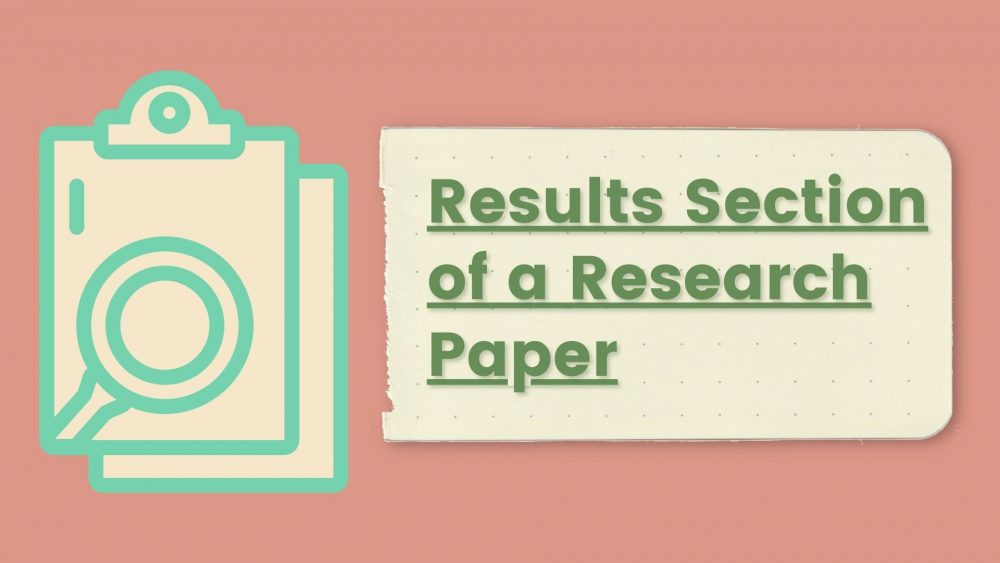The results section of a research paper refers to the part that represents the study’s core findings from the methods that the researcher used to collect and analyze data. This section presents the results logically without interpretation or bias from the author.
Thus, this part of a research paper sets up the read for evaluation and analysis of the findings in the discussion section. Essentially, this section breaks down the information into several sentences, showing its importance to the research question. Writing results section in a research paper entails summarizing the gathered data and the performed statistical analysis. That way, the author presents or reports the results without subjective interpretation.
What Is The Results Section Of A Research Paper?
In its simplest definition, a research paper results section is where the researcher reports the findings of a study based on the applied methodology for gathering information. It’s the part where the author states the research findings in a logical sequence without interpreting them. If the research paper has data from actual research, this section should feature a detailed description of the results.
When writing a dissertation, a thesis, or any other academic paper, the result section should come third in sections’ sequence. It should follow the Methods and Materials presentation and the Discussion section comes after it. But most scientific papers present the Results and Discussion sections together. However, the results section answers the question, “What did your research uncover?”
Ideally, this section allows you to report findings in research paper, creating the basis for sufficiently justified conclusions. After writing the study findings in the results section, you interpret them in the subsequent discussion part. Therefore, your results section should report information that will justify your claims. That way, you can look back on the results section when writing the discussion part to ensure that your report supports your conclusions.
What Goes in the Results Section of a Research Paper?
This section should present results in research paper. The findings part of a research paper can differ in structure depending on the study, discipline, and journal. Nevertheless, the results section presents a description of the experiment while presenting the research results. When writing this part of your research paper, you can use graphs and tables if necessary.
However, state the findings without interpreting them. For instance, you can find a correlation between variables when analyzing data. In that case, your results section can explain this correlation without speculating about the causes of this correlation.
Here’s what to include in the results section of research paper:
- A brief introductory of the context, repeating the research questions to help the readers understand the results
- A report about information collection, participants, and recruitment: for instance, you can include a demographic summary with the participants’ characteristics
- A systematic findings’ description, with a logical presentation highlighting relevant and crucial results
- A contextual data analysis explaining the meaning in sentences
- Information corresponding to the primary research questions
- Secondary findings like subgroup analysis and secondary outcomes
- Visual elements like charts, figures, tables, and maps, illustrating and summarizing the findings
Ensure that your results section cites and numbers visual elements in an orderly manner. Every table or figure should stand alone without text. That means visual elements should have adequate non-textual content to enable the audiences to understand their meanings.
If your study has a broad scope, several variables, or used methodologies that yielded different results, state the most relevant results only based on the research question you presented in your Introduction section.
The general rule is to leave out any data that doesn’t present your study’s direct outcome or findings. Unless the professor, advisor, university faulty, or your target journal requests you to combine the Results and Discussion sections, omit the interpretations and explanations of the results in this section.
How Long Should A Results Section Be?
The findings section of a research paper ranges between two and three pages, with tables, text, and figures. In most cases, universities and journals insist that this section shouldn’t exceed 1,000 words over four to nine paragraphs, usually with no references.
But a good findings section occupies 5% of the entire paper. For instance, this section should have 500 words if a dissertation has 10,000 words. If the educator didn’t specify the number of words to include in this chapter, use the data you collect to determine its length. Nevertheless, be as concise as possible by featuring only relevant results that answer your research question.
How To Write Results Section Of Research Paper
Perhaps, you have completed researching and writing the preceding sections, and you’re now wondering how to write results. By the time you’re composing this section, you already have findings or answers to your research questions. However, you don’t even know how to start a results section. And your search for guidelines landed you on this page.
Well, every research project is different and unique. That’s why researchers use different strategies when writing this section of their research papers. The scientific or academic discipline, specialization field, target journal, and the author are factors influencing how you write this section. Nevertheless, there’s a general way of writing this section, although it might differ slightly between disciplines. Here’s how to write results section in a research paper.
- Check the instructions or guidelines. Check their instructions or guidelines first, whether you’re writing the research paper as part of your coursework or for an academic journal. These guidelines outline the requirements for presenting results in research papers. Also, check the published articles to know how to approach this section. When reviewing the procedures, check content restrictions and length. Essentially, learn everything you can about this section from the instructions or guidelines before you start writing.
- Reflect on your research findings. With instructions and guidelines in mind, reflect on your research findings to determine how to present them in your research paper. Decide on the best way to show the results so that they can answer the research question. Also, strive to clarify and streamline your report, especially with a complex and lengthy results section. You can use subheadings to avoid peripheral and excessive details. Additionally, consider breaking down the content to make it easy for the readers to understand or remember. Your hypothesis, research question, or methodologies might influence the structure of the findings sections. Nevertheless, a hierarchy of importance, chronological order, or meaningful grouping of categories or themes can be an effective way of presenting your findings.
- Design your visual presentations. Visual presentations improve the textual report of the research findings. Therefore, decide on the figures and styles to use in your tables, graphs, photos, and maps. However, check the instructions and guidelines of your faculty or journal to determine the visual aids you can use. Also, check what the guidelines say about their formats and design elements. Ideally, number the figures and tables according to their mention in the text. Additionally, your figures and tables should be self-explanatory.
- Write your findings section. Writing the results section of a research paper entails communicating the information you gathered from your study. Ideally, be as objective and factual as possible. If you gathered complex information, try to simplify and present it accurately, precisely, and clearly. Therefore, use well-structured sentences instead of complex expressions and phrases. Also, use an active voice and past tense since you’ve already done the research. Additionally, use correct spelling, grammar, and punctuation. Take your time to present the findings in the best way possible to focus your readers on your study objectives while preparing them for the coming speculations, interpretations, and recommendations.
- Edit Your Findings Section. Once you’ve written the results part of your paper, please go through it to ensure that you’ve presented your study findings in the best way possible. Make sure that the content of this section is factual, accurate, and without errors. You’ve taken a considerable amount of time to compose the results scientific paper audiences will find interesting to read. Therefore, take a moment to go through the draft and eliminate all errors.
Practical Tips on How to Write a Results Section of a Research Paper
The results part of a research paper aims to present the key findings objectively in a logical and orderly sequence using text and illustrative materials. A common mistake that many authors make is confusing the information in the discussion and the results sections. To avoid this, focus on presenting your research findings without interpreting them or speculating about them.
The following tips on how to write a results section should make this task easier for you:
- Summarize your study results: Instead of reporting the findings in full detail, summarize them. That way, you can develop an overview of the results.
- Present relevant findings only: Don’t report everything you found during your research. Instead, present pertinent information only. That means taking time to analyze your results to know what your audiences want to know.
- Report statistical findings: When writing this section, assume that the audiences understand statistical concepts. Therefore, don’t try to explain the nitty-gritty in this section. Remember that your work is to report your study’s findings in this section.
- Be objective and concise: You can interpret the findings in the discussion sections. Therefore, focus on presenting the results objectively and concisely in this section.
- Use the suitable format: Use the correct style to present the findings depending on your study field.
Get Professional Help with the Research Section
Maybe you’re pursuing your graduate or undergraduate studies but cannot write the results part of your paper. Perhaps, you’re done researching and analyzing information, but this section proves too tricky for you to write. Well, you’re not alone because many students across the world struggle to present their research findings.
Luckily, our highly educated, talented, and experienced writers are always ready to assist such learners. If you are stuck with the results part of your paper, our professionals can help you. We offer high-quality, custom writing help online. We’re a reliable team of experts with a sterling reputation for providing comprehensive assistance to college, high school, and university learners. We deliver highly informative academic papers after conducting extensive and in-depth research. Contact us saying something like, “please do my thesis” to get quality help with your paper!










